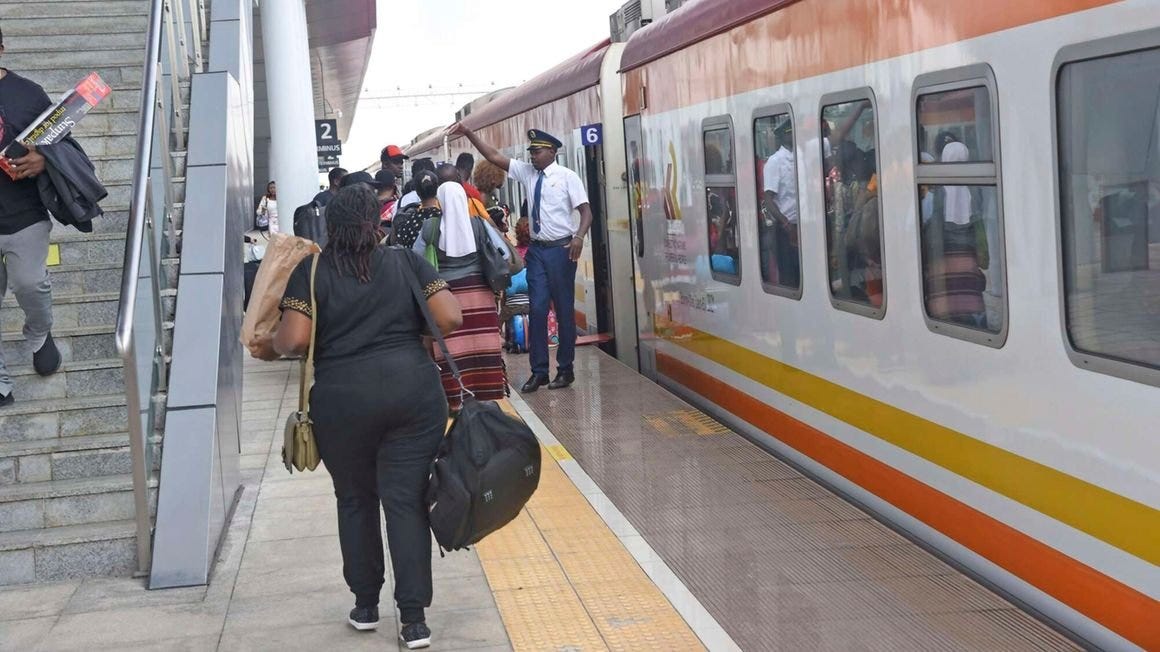Kenya fined Sh1.31 billion by China for failing to repay SGR loans
Kenya borrowed more than half a trillion shillings from Chinese lenders, led by the Export-Import Bank of China, to build the SGR from Mombasa to Naivasha.
Kenya failed to repay Chinese loans used to construct the standard gauge railway (SGR), highlighting the country's struggles with mounting public debt.
According to Treasury documents obtained by Business Daily, Chinese banks fined Kenya Sh1.312 billion for loan defaults in the fiscal year that ended in June.
Kenya borrowed more than half a trillion shillings from Chinese lenders, led by the Export-Import Bank of China, to build the SGR from Mombasa to Naivasha.
Taxpayers have been forced to bear the burden of the SGR loans because revenues from passenger and cargo services on the track are insufficient to cover operating costs, which stood at Sh18.5 billion in the fiscal year to June against Sh15 billion in sales.
"This (Sh1.312 billion) relates to the cost of default on interest at 1% of the due amount," according to disclosure documents obtained by Business Daily.
SGR lost Sh3.4 billion in operations and wired Sh22.7 billion in loan repayments in the fiscal year to June.
The default occurred a year after Kenya requested a six-month extension of the debt repayment moratorium from bilateral lenders, including China, to December 2021, saving it from committing billions to Beijing lenders.
However, the lenders, particularly Exim Bank of China, opposed Kenya's request for a debt repayment holiday, resulting in a stalemate that delayed payments to projects funded by Chinese loans.
In January of last year, China postponed the repayments, allowing Kenya to keep Sh27 billion that was due for six months, ending in June 2021.
To avoid straining relations with Kenya's largest bilateral creditor, Nairobi dropped its push for an extension of the debt repayment holiday due to opposition from Chinese lenders.
China, which accounted for roughly one-third of Kenya's external debt service costs in 2021-22, is the country's second-largest foreign creditor after the World Bank. According to budget documents, Kenya spent a total of Sh117.7 billion on Chinese debt during the period, with approximately Sh24.7 billion in interest payments and nearly Sh93 billion in redemptions.
After a five-year grace period granted by Beijing, Kenya began repaying the SGR loan in January 2020.
The loan default highlights Kenya's financial distress in the face of rapidly maturing debts that have eaten deeply into tax revenues and squeezed funds for development projects.
Former President Uhuru Kenyatta's administration borrowed heavily from China beginning in 2014 to construct roads, bridges, power plants, and the SGR.
This began after Kenya achieved lower-middle-income status, which barred it from receiving highly concessional loans from development lenders such as the World Bank.
However, China's influence on the country's infrastructure development began in earnest with the construction of the Thika Superhighway between January 2009 and November 2012 at a cost of nearly Sh32 billion during President Mwai Kibaki's last term.
With the agreement to fund the first phase of the SGR, Kenya's single-largest infrastructure project in terms of cost since independence, China surpassed Japan as the country's largest bilateral lender.
Kenya's debt has more than quadrupled to Sh8.58 trillion under Kenyatta's administration.
According to the International Monetary Fund, the increase in liabilities put the country at high risk of debt distress (IMF).
The cost of servicing public debt is expected to rise by a third to a record Sh1.39 trillion in the fiscal year ending June 2023, accounting for more than half of projected State revenue.
According to the Treasury, Kenya spent nearly 57 percent of tax revenue in the previous fiscal year on loan repayment, highlighting the effects of mounting public debt on state finances.
The terms of China's loans to developing countries are unusually opaque, with borrowers required to prioritise repayment to Chinese state-owned banks over other creditors.
A cache of such contracts was revealed in a previous Reuters report.
The dataset, compiled over three years by AidData, a US research lab at the College of William & Mary, consists of 100 Chinese loan contracts with 24 low- and middle-income countries, many of which are struggling with mounting debt as a result of the Covid-19 pandemic's economic fallout.
It uncovered several unusual features, such as confidentiality clauses that prevent borrowers from disclosing loan terms, informal collateral arrangements that favour Chinese lenders over other creditors, and promises to keep the debt out of collective restructurings – dubbed "no Paris Club" clauses by the authors.
The Paris Club is a group of officials from major creditor countries tasked with finding solutions to debtor countries' payment problems.
President William Ruto reversed one of the previous administration's most contentious policies, which required cargo clearance at the inland container depots in Nairobi and Naivasha.



